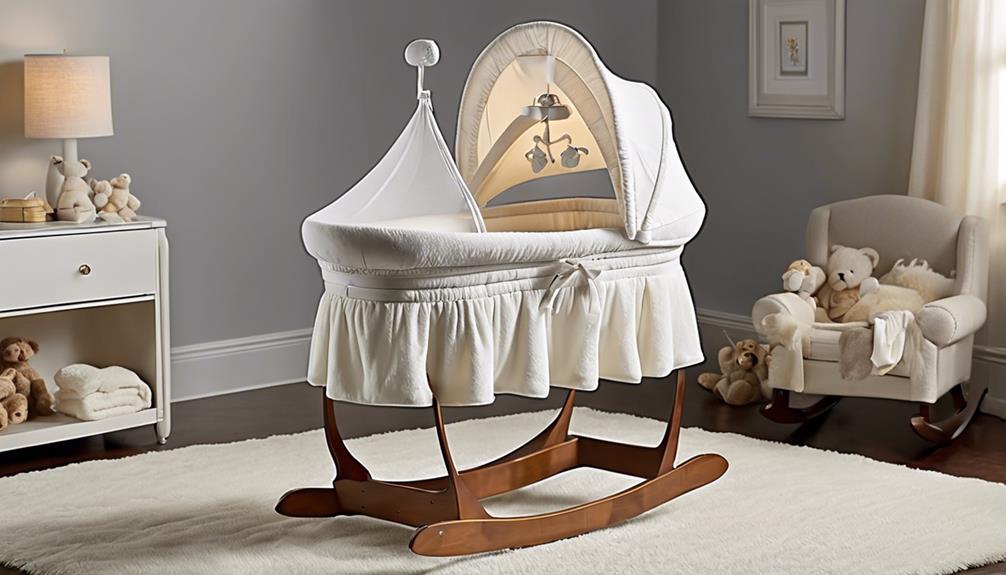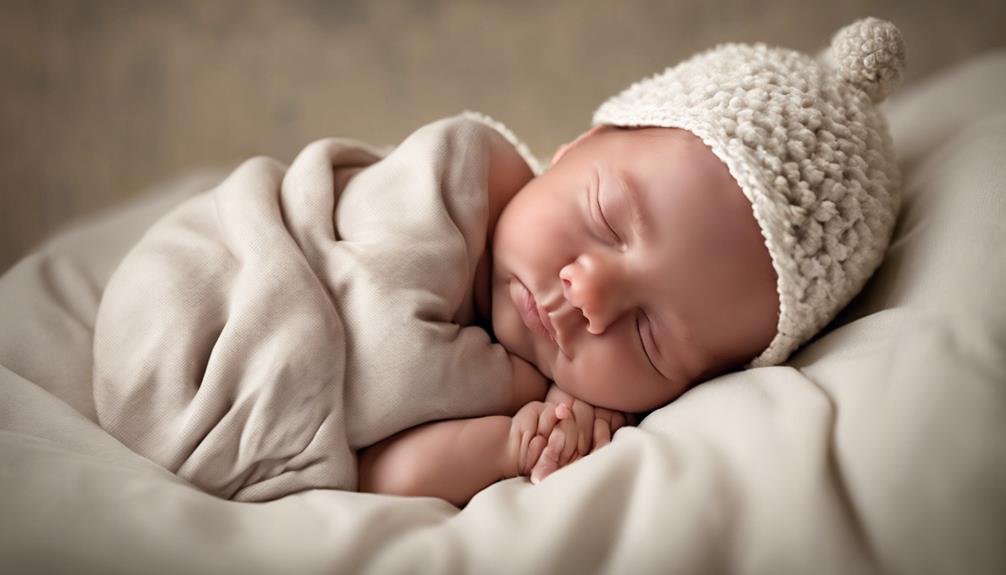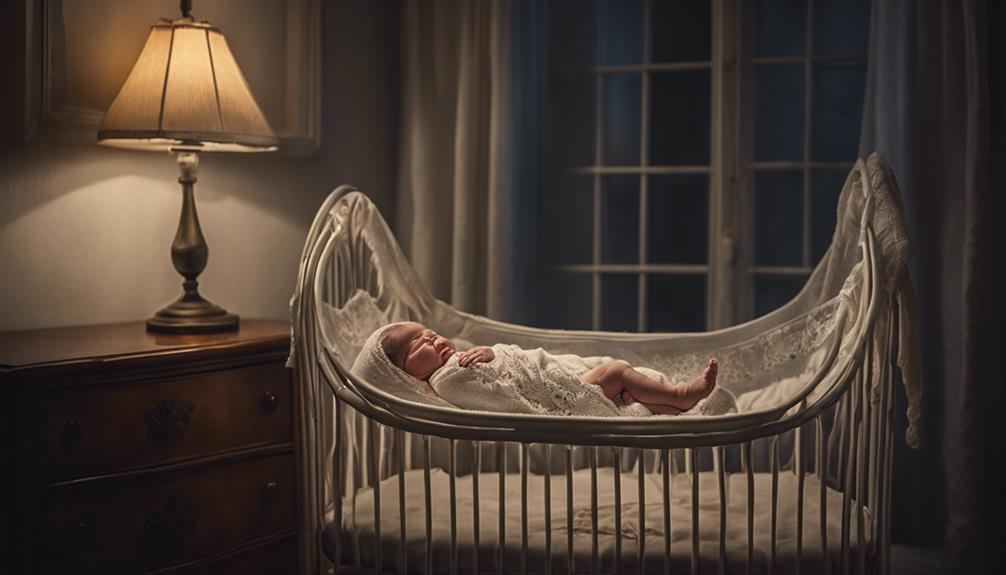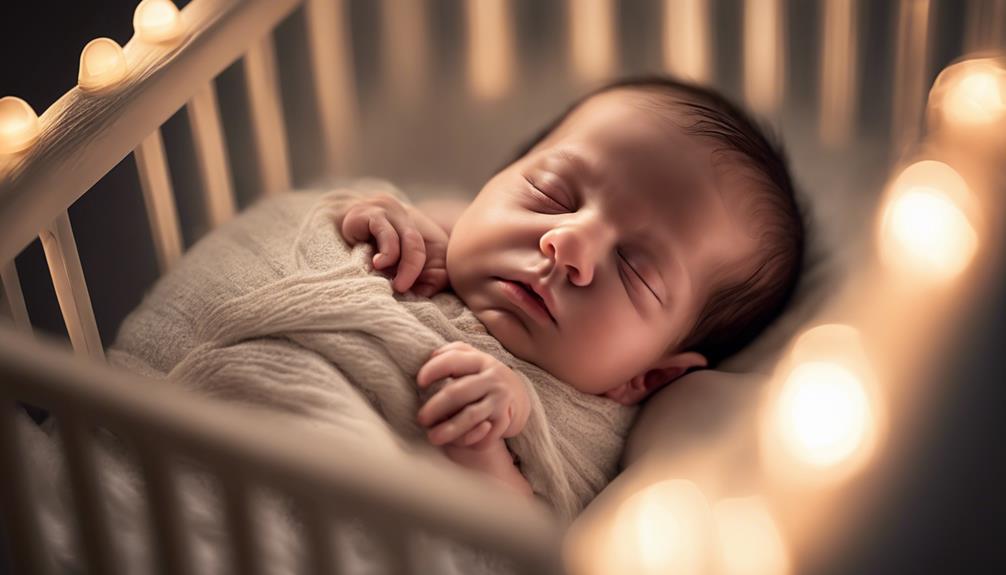As parents, we all aim for those peaceful nights where our newborns drift off to sleep in the bassinet without a fuss. But how do we achieve this elusive goal?
Well, it all starts with establishing a soothing bedtime routine and ensuring a comfortable sleep environment. These are just the first steps in a series of tips that can make a real difference in your baby's sleep quality.
Stay tuned to discover the remaining strategies that will help you navigate the world of newborn sleep with more ease and confidence.
Key Takeaways
- Establish a calming bedtime routine and environment for your newborn's peaceful sleep.
- Swaddle your newborn securely for comfort and security during sleep.
- Use white noise to create a soothing sleep environment and improve sleep quality.
- Follow safe sleep practices and maintain a consistent sleep schedule for your newborn's well-being.
Establish a Soothing Bedtime Routine
Let's create a calming bedtime routine to help your newborn sleep soundly in the bassinet. Establishing a soothing bedtime routine can work wonders in preparing your baby for a peaceful night's sleep. Start by incorporating calming activities like a warm bath or gentle massage to signal to your little one that it's time to unwind and relax. Utilize soft music or white noise in the background to create a serene environment that aids in easing your baby into sleep mode in the bassinet.
Dim the lights in the room to set a tranquil atmosphere, signaling to your baby that bedtime is approaching. Before placing your little one in the bassinet, try gentle rocking or swaying motions to mimic the comforting sensation of being held, which can help in the shift to sleep. Establish a predictable sequence of events before bedtime, such as feeding, diaper change, and swaddling, to help your newborn feel secure and ready for a restful night in the bassinet.
Ensure a Comfortable Sleep Environment

We grasp the significance of establishing a cozy and safe sleep environment for your newborn in the bassinet.
Let's discuss how to guarantee soft bedding safety, control room temperature effectively, and utilize the advantages of white noise for a restful night's sleep.
These factors play an essential role in assisting your little one feel secure and comfortable as they drift off to sleep in their bassinet.
Soft Bedding Safety
Soft bedding safety is important for ensuring a comfortable sleep environment for your newborn in the bassinet. When setting up your baby's sleep space, it's essential to follow safe sleep guidelines to reduce the risk of suffocation and Sudden Infant Death Syndrome (SIDS). Opt for a firm mattress with a fitted sheet to provide a secure sleep surface for your little one. Avoid using soft bedding such as loose blankets, pillows, or stuffed animals in the bassinet, as they can pose risks to infants. By prioritizing a safe sleep environment, you can promote better sleep quality for your newborn while ensuring their well-being. Here's a helpful table to guide you:
| Safe Sleep Guidelines | Recommended for Newborns |
|---|---|
| Firm Mattress | ✔ |
| Fitted Sheet | ✔ |
| Soft Bedding | ❌ |
| Suffocation Risk | High |
| SIDS Risk | Increased |
Room Temperature Control
Maintaining a room temperature of 68-72 degrees Fahrenheit is important for creating an ideal sleep environment for your newborn in the bassinet. Dressing your newborn in light, breathable layers helps prevent overheating during sleep. Use a room thermometer to monitor and adjust the temperature as needed for comfort.
Avoid direct drafts or heat sources near the bassinet to guarantee a consistent sleeping environment. Consistent room temperature is vital as it helps regulate your baby's body temperature, ultimately promoting better sleep quality. By keeping the room comfortably cool and free from extreme temperature fluctuations, you provide a cozy and safe space for your little one to rest peacefully in the bassinet.
White Noise Benefits
To create a soothing sleep environment for your newborn in the bassinet, consider the benefits of incorporating white noise. White noise machines can mimic the comforting sounds of the womb, helping babies sleep better.
They create a safe sleep space by masking background noises that may startle newborns awake, promoting longer and more restful sleep.
Using white noise consistently can establish healthy sleep habits, signaling bedtime or naptime for your little one. Research shows that white noise can reduce the risk of frequent awakenings, improving sleep quality for newborns.
Swaddle Your Newborn for Security
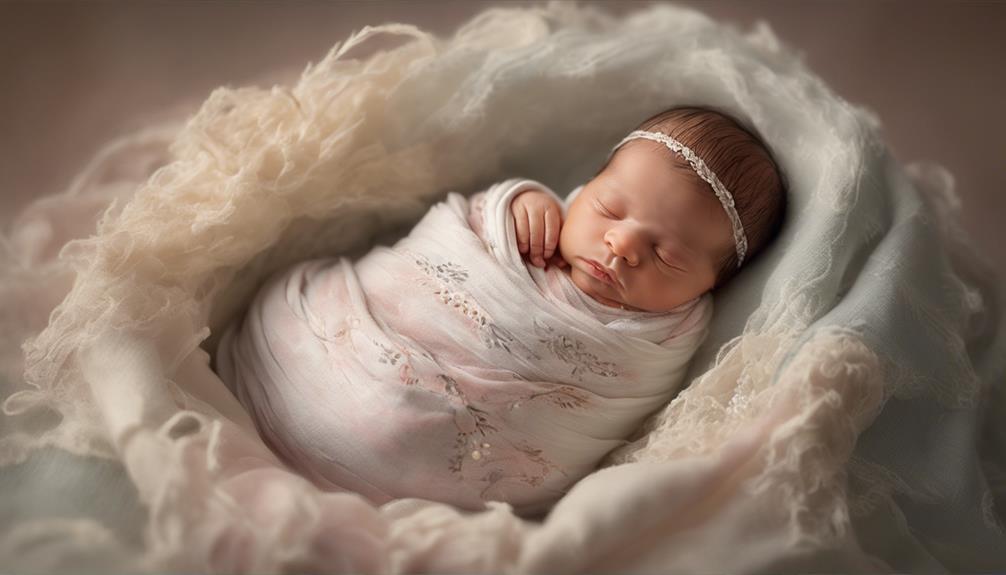
When it comes to swaddling your newborn, it's all about providing comfort and safety.
Swaddling can help your baby feel secure, preventing unnecessary wake-ups from the startle reflex.
It's a simple yet effective way to promote better sleep and peace of mind for both you and your little one.
Swaddle for Comfort
Swaddling your newborn is a comforting practice that can help enhance their sense of security and promote sound sleep in the bassinet. Here are some essential points to contemplate when swaddling for comfort:
- Mimic the Womb: Create a snug environment that reminds the baby of the womb, promoting comfort and security.
- Prevent Startle Reflex: Proper swaddling prevents the startle reflex, ensuring longer, more restful sleep periods.
- Regulate Body Temperature: Swaddling helps regulate body temperature, keeping the baby cozy for a comfortable sleep environment.
- Create a Calming Effect: Correct swaddling techniques can have a calming effect on newborns, facilitating a smoother shift in sleep in the bassinet.
Safety in Swaddling
As parents, we comprehend the importance of guaranteeing your newborn feels safe and secure while swaddled in the bassinet. Swaddling not only provides a sense of security but also helps prevent the startle reflex, promoting longer and more restful sleep. When swaddling your baby, guarantee the wrap is snug yet allows for proper hip movement and breathing.
This technique can also be soothing for babies with colic, aiding in self-soothing and settling in the bassinet. Remember to use a lightweight, breathable fabric to avoid overheating and always follow safe sleep guidelines to reduce the risk of SIDS.
Prioritizing these safety measures will help your newborn sleep soundly and peacefully in the bassinet.
Use White Noise or Gentle Sounds
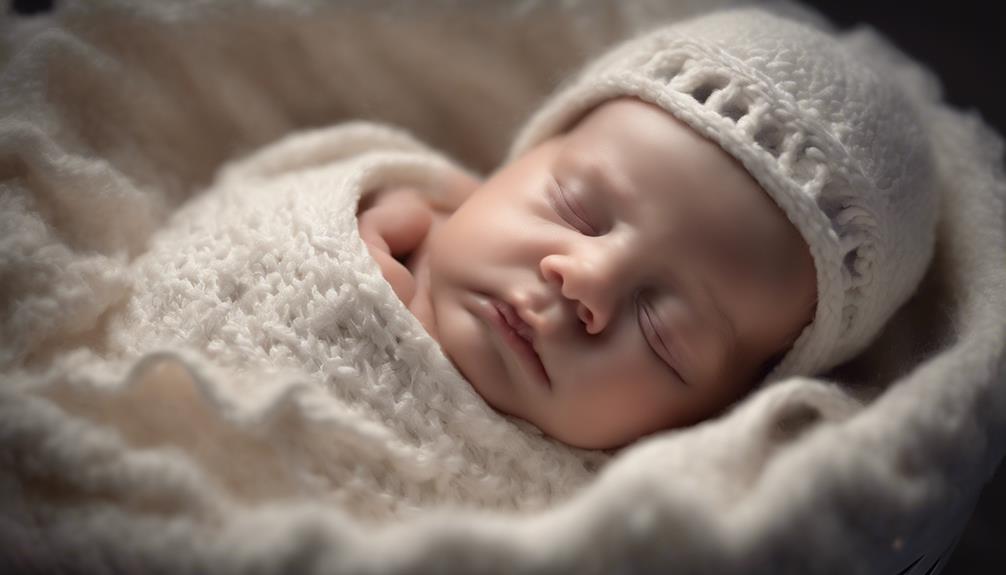
To create a soothing environment for your newborn in the bassinet, consider using white noise or gentle sounds. Here are some tips to help you incorporate these calming sounds:
- White Noise Machines: Invest in a quality white noise machine that can provide a constant and calming sound to mask background noises and help your baby relax in the bassinet.
- Consistent White Noise: The consistent sound of white noise can mimic the womb environment, promoting better sleep and relaxation for your little one.
- Lullabies and Nature Sounds: Pairing gentle lullabies or nature sounds with white noise can enhance the soothing effects, creating a peaceful atmosphere for your newborn to drift off to sleep.
- Improved Sleep Quality: Research suggests that white noise can reduce the time it takes for babies to fall asleep and improve the overall quality of their sleep in the bassinet.
Try a Gentle Rocking Motion

When your newborn is struggling to settle down in the bassinet, gently rocking them can mimic the comforting movements they experienced in the womb, helping to soothe and ease them into sleep. Babies often find the rhythmic motion of rocking to be incredibly soothing, especially when they're feeling fussy or having trouble changing into sleep. The gentle swaying can create a sense of calm and relaxation, making it easier for your little one to drift off into drowsiness.
Whether you choose to manually rock your baby or utilize a bassinet with a gentle rocking feature, the key is to keep the movements smooth and consistent. Avoid excessive rocking, as we want to prevent your baby from becoming dependent on motion for sleep. By incorporating a gentle rocking motion into your bedtime routine, you can help create a comforting environment that promotes a peaceful and restful sleep for your newborn.
Implement a Consistent Sleep Schedule
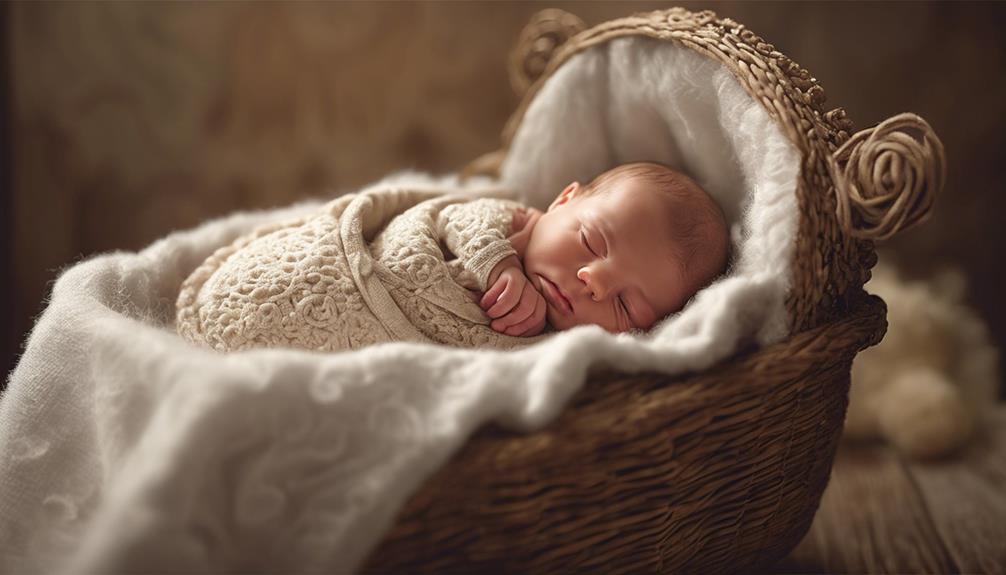
Let's talk about the importance of setting a bedtime routine and using white noise to establish a consistent sleep schedule for your newborn.
By creating a predictable pattern before bedtime, such as a gentle rocking motion and soothing white noise, you can help signal to your baby that it's time to settle down and rest in the bassinet.
Following these practices can aid in regulating your little one's internal clock, leading to better sleep quality and duration.
Set Bedtime Routine
Establishing a consistent bedtime routine is key to helping your newborn adjust to a structured sleep schedule and settle peacefully in the bassinet. Here are some tips to guide you through this process:
- Set a fixed bedtime: Choose a time that works for your family and stick to it every night.
- Create a calming pre-sleep routine: Incorporate activities like a warm bath or gentle lullabies to signal that bedtime is approaching.
- Dim the lights: Lowering the lights in the evening can help your baby understand it's time to wind down.
- Avoid stimulating activities: Refrain from bright screens or loud noises before bedtime to promote a peaceful environment.
Use White Noise
As parents of a newborn, we comprehend the importance of using white noise to create a soothing environment and implementing a consistent sleep schedule to help your baby settle and sleep soundly in the bassinet.
White noise can drown out background sounds, mimicking the gentle sounds of the womb environment. This continuous sound can signal to your newborn that it's time to sleep, aiding in improved sleep quality.
Consider a Pacifier for Soothing

Wondering how a pacifier could help your newborn sleep more soundly in the bassinet? Here's why it might be beneficial:
- Soothe: Pacifiers can help soothe newborns by satisfying their natural sucking reflex, providing comfort in the bassinet.
- Reduce SIDS Risk: Studies have shown that pacifier use during sleep can reduce the risk of SIDS, offering peace of mind.
- Support Sleep Habits: Introducing a pacifier after breastfeeding is established can support healthy sleep habits, aiding in bedtime routines.
- Encourage Self-Soothing: Pacifiers can aid in self-soothing for babies in the bassinet, helping them learn to settle themselves.
When considering a pacifier for your newborn, remember that it can serve as a valuable tool in promoting better sleep. By incorporating it into your bedtime routine, you can signal to your baby that it's time to rest, creating a comforting environment for peaceful slumbers.
Monitor Room Temperature for Optimal Sleep
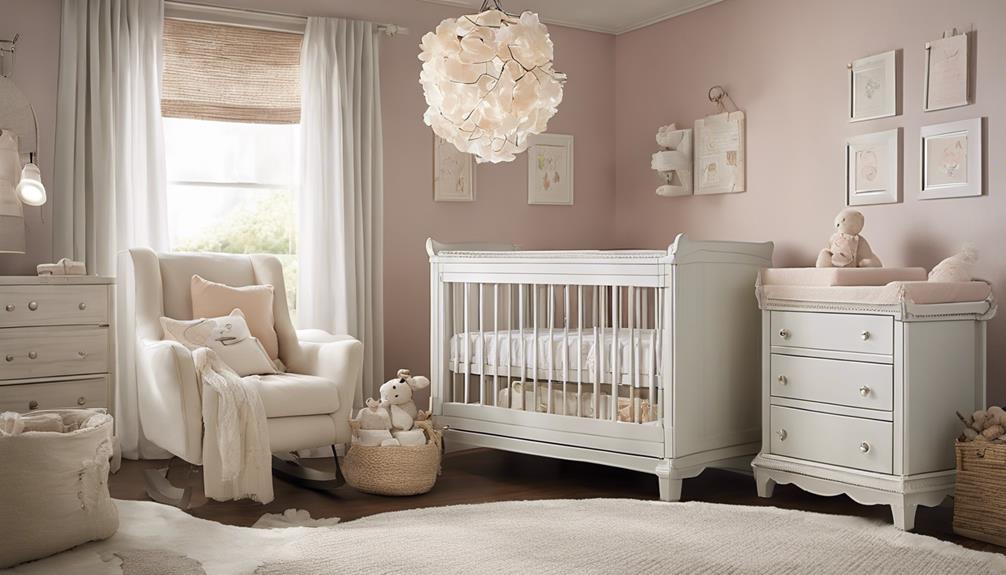
To guarantee your newborn sleeps efficiently in the bassinet, it's vital to carefully monitor the room temperature within the recommended range of 68-72 degrees Fahrenheit. Using a thermometer can help make sure the room is just right for your little one, not too hot or too cold. Overheating poses a risk of SIDS, so it's important to regulate the temperature effectively. Remember to dress your baby in one layer less than what you're wearing to prevent overheating during sleep. Maintaining a comfortable room temperature creates ideal sleep conditions, promoting a safe and soothing environment for your newborn in the bassinet.
| Room Temperature | Importance |
|---|---|
| 68-72°F | Ideal for newborn sleep |
| Thermometer | Check for ideal conditions |
| Overheating | Increases SIDS risk |
| Regulate Temperature | Ensure baby's comfort |
| Bassinet | Safe sleep space |
Use Dim Lighting During Nighttime Sleep

Ensuring a calming environment for your newborn's nighttime sleep, dim lighting plays an essential role in signaling the body to produce melatonin and promoting relaxation in the bassinet.
Here's how dim lighting can help your baby sleep soundly in the bassinet:
- Melatonin Production: Dim lighting triggers the body to release melatonin, a hormone that regulates sleep-wake cycles, helping your baby ease into sleep.
- Circadian Rhythm Regulation: Soft, low lighting assists in setting your baby's internal clock, letting them know it's time to rest and aiding in the formation of healthy sleep patterns.
- Overstimulation Prevention: By avoiding bright lights at night, you can prevent overstimulation, creating a soothing atmosphere that encourages relaxation.
- Restful Sleep: Using dim lighting fosters a secure and comfortable environment, promoting deeper and more restful sleep for your little one in the bassinet.
Practice Safe Sleep Practices
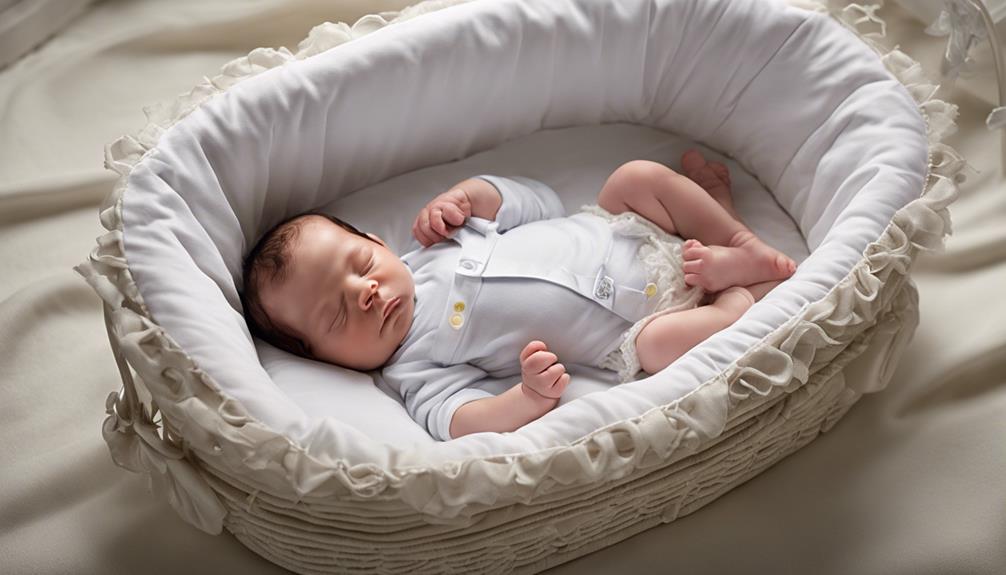
Implementing safe sleep practices is important for ensuring your newborn's well-being and promoting healthy sleep habits in the bassinet. Following the American Academy of Pediatrics (AAP) guidelines, always remember to place your newborn on their back to sleep, reducing the risk of SIDS. Use a firm and flat mattress in the bassinet to provide a safe sleeping surface. Avoid placing soft bedding, toys, or pillows in the bassinet, as these can pose suffocation hazards. Keep the sleep environment free of loose blankets and bedding. For added safety and convenience, consider room-sharing with your newborn by placing the bassinet next to your bed. This allows for easy monitoring and comforting during the night. By practicing these safe sleep practices, you can create a secure sleep space for your newborn, promoting better sleep quality and reducing the risk of SIDS.
| Safe Sleep Practices | Description | Importance |
|---|---|---|
| Back to sleep | Placing newborn on their back | Reduce SIDS risk |
| Firm mattress | Firm and flat surface for sleep | Prevent injuries |
| Room-share | Keeping bassinet close for monitoring | Enhance safety |
Conclusion
As we gently lay our precious newborn down in the cozy bassinet, surrounded by soft swaddles and soothing white noise, we create a tranquil haven for sweet dreams to unfold.
The dim lights cast a warm glow, embracing our little one in a cocoon of comfort.
With each peaceful breath and gentle movement, we watch over them with love and care, knowing that they're safe and sound in their peaceful slumber.
Good night, sweet baby.
